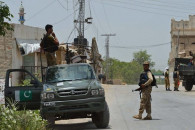Flood threat looms over katcha areas in Sindh
CM hopes flood won't cross 900,000-cusec mark; visits dykes, barrages in Sukkur, Larkana

With torrents continuing to rise in Punjab's rivers, Sindh is bracing to cope with a potential super flood of 900,000 cusecs or more, with protection of human lives, livestock, barrages and embankments declared the government's foremost priority.
"The entire katcha (riverine) belt of Sindh is going to be inundated," Chief Minister Murad Ali Shah cautioned during visits to dykes and barrages in Sukkur and Larkana divisions on Sunday.
CM Shah, however, expressed hope that the flood level would not cross the 900,000-cusec mark. Yet, recalling the 2010 super flood, he stated that the province had then prepared for 650,000 to 700,000 cusecs at Guddu barrage but the actual flow surged to 1.15 million cusecs. That disaster displaced millions, damaged tens of thousands of houses, crops and businesses, claimed more than 400 lives, wiped out hundreds of thousands of livestock, and inflicted losses worth Rs373 billion.
According to the chief minister, the government's extensive mapping of riverine populations has projected different scenarios of displacement. Between Guddu and Sukkur barrages alone, some 459,000 people would be affected if a torrent of 900,000 cusecs or more strikes. Earlier, Senior Minister Sharjeel Inam Memon had estimated that 1.65 million people reside in Sindh's riverine belt.
CM Shah shared that 130,941 people and 21,823 families would be affected between Guddu and Sukkur if water flow remained between 500,000 and 700,000 cusecs. The number would swell by another 104,255 people and 17,376 families if the flow rises to between 700,000 and 900,000 cusecs.
The provincial government has planned to set up 948 relief camps, though Shah estimated that around 514 would practically be established. Two Pakistan Navy teams have already been deployed on both banks of the river while more would be sent if required. CM Shah said the army's assistance would also be sought if needed.
Uncertain forecasts
Irrigation experts are still unable to estimate the volume of water that will enter Sindh at Guddu. CM Shah said clearer figures would emerge once peak flows from the Chenab and Jhelum rivers reach Trimu in Punjab. From Trimu, the torrent takes over three days to reach Panjnad — the confluence of Punjab's five rivers — and then about two more days to Guddu.
The chief minister said the deluge is expected to reach Guddu in five to six days, but expressed hope that its intensity would lessen. He pointed out that the flow recorded 855,000 cusecs under Chiniot bridge but had dropped to 435,000 cusecs at Trimu on Sunday afternoon, as water spread into settled areas of Punjab.
Vulnerable embankments
CM Shah disclosed that six vulnerable dykes have been identified between Guddu and Sukkur, with Qadirpur Shaink bund in Ghotki (left bank) and KK bund (right bank) posing the highest concern. On August 24, a flow of 550,000 cusecs passed through Guddu and both embankments held, but the CM admitted it was unclear if they could withstand 900,000 cusecs.
The chief minister explained that Shaink is a protective bund backed by a loop bund, which would prevent water from reaching outside settlements, but warned that people living between the two embankments would still be affected.
He urged residents of riverine villages to evacuate voluntarily and cooperate with authorities, while also appealing to the media to avoid spreading panic.
Monitoring and rehabilitation
Sindh Irrigation Minister Jam Khan Shoro and Secretary Irrigation Zareef Khehro briefed CM Shah that 3,280 staff had been deployed along the left bank embankments and 2,064 along the right bank between Guddu and Sukkur. The Qadirpur Shaink, Qadirpur loop, Raonti, Baiji and RN levees were declared highly sensitive to potential breaches or overflow.
The CM was also informed that rehabilitation of Guddu barrage, initiated in 2017, has been 72 per cent completed, while gate repairs and installation are still in progress. Shah directed that the project must be completed by March 2026 without further delay.
While reiterating his hope that the flood quantum would remain lower than the 2010 deluge, CM Shah stressed that his government was fully mobilised to protect people, infrastructure and agriculture from any eventuality.



















COMMENTS (1)
Comments are moderated and generally will be posted if they are on-topic and not abusive.
For more information, please see our Comments FAQ